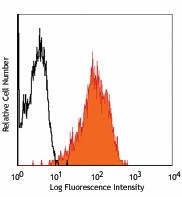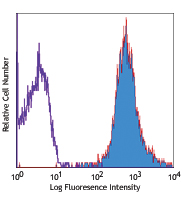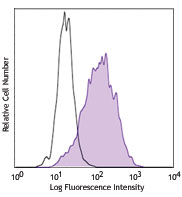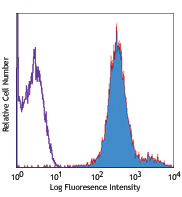- Clone
- 3D12 (See other available formats)
- Regulatory Status
- RUO
- Other Names
- HLA class I histocompatibility antigen, alpha chain E, HLAE
- Isotype
- Mouse IgG1, κ
- Ave. Rating
- Submit a Review
- Product Citations
- publications

-

Human peripheral blood lymphocytes stained with 3D12 PE
| Cat # | Size | Price | Save |
|---|---|---|---|
| 342603 | 25 tests | ¥23,760 | |
| 342604 | 100 tests | ¥57,640 |
HLA-E is a non-classical MHC class I (MHC-Ib) molecule. It is characterized by limited polymorphism and ubiquitous expression. HLA-E, as other MHC-I molecules, is heterodimerized with β2-microglobulin. HLA-E interacts with CD94/NKG2 receptor to regulate NK cell cytolysis activities.
Product DetailsProduct Details
- Reactivity
- Human
- Antibody Type
- Monoclonal
- Host Species
- Mouse
- Formulation
- Phosphate-buffered solution, pH 7.2, containing 0.09% sodium azide and BSA (origin USA)
- Preparation
- The antibody was purified by affinity chromatography, and conjugated with PE under optimal conditions.
- Concentration
- Lot-specific (to obtain lot-specific concentration and expiration, please enter the lot number in our Certificate of Analysis online tool.)
- Storage & Handling
- The antibody solution should be stored undiluted between 2°C and 8°C, and protected from prolonged exposure to light. Do not freeze.
- Application
-
FC - Quality tested
- Recommended Usage
-
Each lot of this antibody is quality control tested by immunofluorescent staining with flow cytometric analysis. For flow cytometric staining, the suggested use of this reagent is 5 µl per million cells in 100 µl staining volume or 5 µl per 100 µl of whole blood.
- Excitation Laser
-
Blue Laser (488 nm)
Green Laser (532 nm)/Yellow-Green Laser (561 nm)
-
Application References
(PubMed link indicates BioLegend citation) -
- Lee N, et al. 1998. Proc. Natl. Acad. Sci. USA. 95:5199.
- Wooden SL, et al. 2005. J. Immunol. 175:1383.
- Monaco EL, et al. 2008. J. Immunol. 181:5442.
- Corrah TW, et al. 2011. J. Virol. 85:3367. PubMed
- Product Citations
- RRID
-
AB_1659250 (BioLegend Cat. No. 342603)
AB_1659249 (BioLegend Cat. No. 342604)
Antigen Details
- Structure
- HLA family, Ig superfamily, 42 kD
- Distribution
-
Broadly expressed
- Function
- Mediate cell recognition by NK cells
- Ligand/Receptor
- CD94/NKG2
- Biology Area
- Immunology
- Molecular Family
- MHC Antigens
- Antigen References
-
1. Sullivan LC, et al. 2008. Tissue Antigen. 72:415.
2. Koller BH, et al. 1988. J. Immunol. 141:897. - Gene ID
- 3133 View all products for this Gene ID
- UniProt
- View information about HLA-E on UniProt.org
Related FAQs
- What type of PE do you use in your conjugates?
- We use R-PE in our conjugates.
Customers Also Purchased




Compare Data Across All Formats
This data display is provided for general comparisons between formats.
Your actual data may vary due to variations in samples, target cells, instruments and their settings, staining conditions, and other factors.
If you need assistance with selecting the best format contact our expert technical support team.












Follow Us